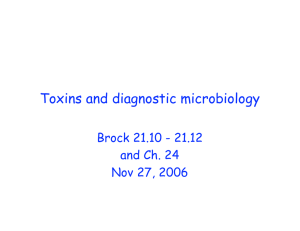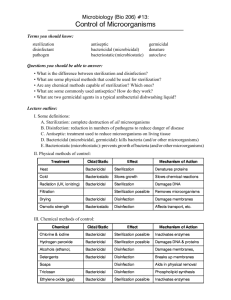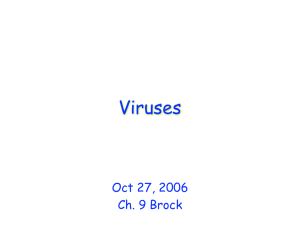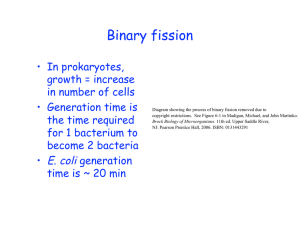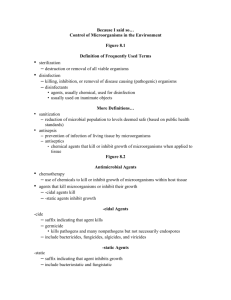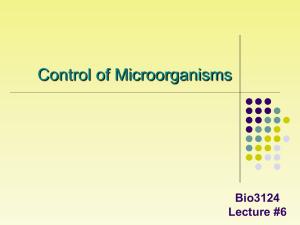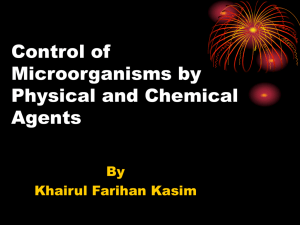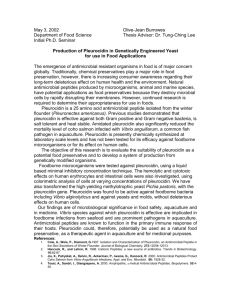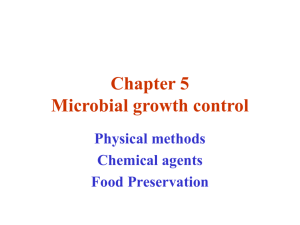Document 10287922
advertisement
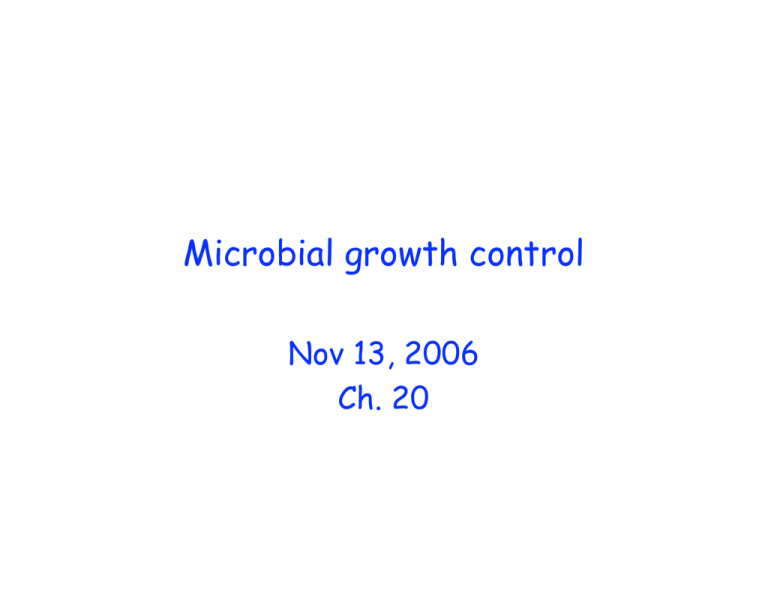
Microbial growth control Nov 13, 2006 Ch. 20 Outline 1. 2. 3. 4. Physical antimicrobial control Chemical antimicrobial control Antimicrobial agents used in vitro Control of viruses and eukaryotic pathogens 5. Antimicrobial drug resistance and drug discovery Physical antimicrobial control • Heat sterilization – Autoclave – Pasteurization • Radiation sterilization – Ionizing radiation • Filter sterilization – Depth filters – Membrane filters • Death is a first order function • Time required for a 10-fold reduction in population density at a given temp. is the decimal reduction time (D) • Thermal death time can also be used Survival Fraction (log scale) Measuring heat sterilization 100 Decimal reduction time (D) 50C 10 1 70C 60C 0.1 10 30 20 Time (min) 40 50 Figure by MIT OCW. Autoclave • 15 psi yields 121°C • Kills bacterial spores within 15 Autoclave images removed due to copyright restrictions. See Figures 20-3a and 20-3c in Madigan, Michael, and John Martinko. Brock Biology min of Microorganisms. 11th ed. Upper Saddle River, NJ: Pearson Prentice Hall, 2006. ISBN: 0131443291. • Larger volumes of liquid require extended cycle times Pasteurization • Reduces microbial population in milk and other heat-sensitive liquids • Uses a heat exchanger • Controlled flow rate and temp. • Flash pasteurization is 71°C for 15 seconds • Controls Listeria, Campylobacter, Salmonella, E. coli, etc. Photograph of jugs of milk being pasteurized removed due to copyright restrictions. www.discoveriesinmedicine.com Radiation sterilization • UV limited to disinfection of exposed surfaces and some water applications • Ionizing radiation used for medical supplies and food • Typically x-rays or γ-rays from 60Co or 137Cs source Table showing the radiation sensitivity of microorganisms and biological functions removed due to copyright restrictions. See Table 20-1 in Madigan, Michael, and John Martinko. Brock Biology of Microorganisms. 11th ed. Upper Saddle River, NJ: Pearson Prentice Hall, 2006. ISBN: 0131443291. Filter sterilization • Depth filters trap particles within the layers of the mat – Pre-filters – High-efficiency particulate air (HEPA) filters • Membrane filters are used for heatsensitive liquids Filter images removed due to copyright restrictions. See Figure 20-6b in Madigan, Michael, and John Martinko. Brock Biology of Microorganisms. 11th ed. Upper Saddle River, NJ: Pearson Prentice Hall, 2006. ISBN: 0131443291. • Bacteriocidal • Bacteriolytic – Detergents and cell wall synthesis inhibitors Figure by MIT OCW. Log Cell Number – Agents often binds reversibly to ribosomes Log Cell Number • Selective toxicity • Bacteriostatic Log Cell Number Chemical growth control Bacteriostatic Total cell count Viable cell count Bacteriocidal Bacteriolytic Time Measuring antimicrobial activity • Minimum inhibitory concentration (MIC) • Tube dilution technique • Agar disc diffusion • Both require standardization Photograph showing the minimum inhibitory concentration in a series of increasingly diluted test tubes removed due to copyright restrictions. See Figure 20-10 in Madigan, Michael, and John Martinko. Brock Biology of Microorganisms. 11th ed. Upper Saddle River, NJ: Pearson Prentice Hall, 2006. ISBN: 0131443291. www.oceanexplorer.noaa.gov Chemical agents used externally • Control of non-pathogenic microbes • Control of pathogenic microbes in the environment – Sterilants • Cold sterilization • Ethylene oxide gas, sodium chlorite solution – Disinfectants • Decontaminate floors, tables, etc. • Antiseptics can be used topically Table of antiseptics, sterilants, disinfectants, and sanitizers removed due to copyright restrictions. See Table 20-4 in Madigan, Michael, and John Martinko. Brock Biology of Microorganisms. 11th ed. Upper Saddle River, NJ: Pearson Prentice Hall, 2006. ISBN: 0131443291. Antimicrobials used in vivo • Chemotherapeutics • Synthetic drugs • Growth factor analogs – Sulfa drugs • Sulfanilamide is an analog of para aminobenzoic acid, a precursor for folic acid – Bacteria synthesize folic acid – Sulfamethoxazole plus trimethoprim is used clinically Sulfanilamide H 2N SO2NH2 p-Aminobenzoic acid H 2N COOH Figure by MIT OCW. More synthetic antimicobials • Isoniazid – Only effective against Mycobacterium tuberculosis – Nicotinamide analog – Inhibits mycolic acid synthesis • Quinolones – Inhibit DNA gyrase F HN N O COOH N • Nalidixic acid • Fluoroquinolone derivatives Ciprofloxacin Figure by MIT OCW. Antibiotics • Broad-spectrum vs. narrow spectrum • Targets include ribosomes, the cell wall, the cytoplasmic membrane, and RNA Pol 1. 2. 3. 4. Penicillins and cephalosporins Aminoglycosides Macrolide antibiotics Tetracyclines β-lactam antibiotics • Penicillin G first antibiotic discovered – Highly selective – Primarily active against gram positive bacteria – Many semisynthetic pencillins are effective against gram negative bacteria – Sensitive to β-lactamase • Bind irreversibly to penicillin-binding proteins (transpeptidases) and prevent cross-linking of peptidoglycan chains • Cephalosporins have broader spectrum and are resistant to β-lactamases Aminoglycosides • Produced by bacteria and active against bacteria • Inhibit protein sythesis (30S subunit) • Useful clinically against gram negative bacteria • Neurotoxicity and nephrotoxicity • Used as fallback; not initial drugs of choice Macrolides and tetracyclines – Large lactone rings – Important group (11% of all antibiotics produced worldwide) – Erythromycin is commonly used in patients allergic to penicillin – Inhibit 50S subunit of the ribosome • Tetracyclines – Inhibits 30S subunit of the ribosome – Still widely used; growing problem of resistance Antimicrobial drug resistance • Acquired ability to resist effects of a chemotherapeutic to which it is normally susceptible • Common mechanisms 1. Lack structure drug targets 2. May be impermeable to drug 3. Organism may be able to modify drug to an inactive form 4. Organism may modify the target itself 5. Organism may develop a new pathway 6. Organism may be able to pump out the drug R plasmids • Most drug resistant bacteria isolated from patients contain drug resistance genes on plasmids • Many R plasmids encode enzymes that inactivate drugs • R plasmids predate medical use of antibiotics • Widespread emergence of multi-drug resistance Resistance to all known drugs… Acinetobacter sp. • Methicillin- resistant Staphylococcus aureus (MRSA) • Vancomycinresistant Enterococcus (VRE) Enterococcus faecalis Streptococcus pneumoniae Gram-negative Gram-positive Gram-positive/acid-fast Mycobacterium tuberculosis Haemophilus ducreyi Salmonella typhi Haemophilus influenzae Neisseria gonorrhoeae Pseudomonas aeruginosa Salmonella sp. Shigella dysenteriae Shigella sp. Other gram-negative rods Staphylococcus aureus 1950 1960 1970 1980 Figure by MIT OCW. 1990 2000 2010
